Data on births presented in this release were obtained from the timely and late registered births at the Office of the City Civil Registrar of Parañaque and submitted to the Office of the Civil Registrar General through the Philippine Statistics Authority – National Capital Region - Provincial Statistical Office V (PSA-NCR-PSO V). The information presented includes births by the usual residence of the mother that occurred from January to December 2023 based on data files received by the PSA - Civil Registration Service (CRS) from the PSOs and processed as of 31 August 2024. The figures presented herein are not adjusted for under registration.
Registered live births in the City of Parañaque slightly increased in 2023.
In 2023, the City of Parañaque recorded 8,108 registered live births, a slight 0.3 percent increase from 2022. This marks the second year of modest recovery following significant declines during the COVID-19 pandemic. From 2014 to 2018, births consistently exceeded 10,800, peaking at 11,568 in 2014. However, a downward trend began in 2019 and worsened during the pandemic, with a 12.1 percent drop in 2020 and 17.1 percent in 2021. While increases were seen in 2022 and 2023, birth numbers remain about 30 percent lower than in 2014. Meanwhile, the city reported a crude birth rate of 10.4, or approximately 10 births per 1,000 population, with an average of 22 births per day. (See Figure 1)
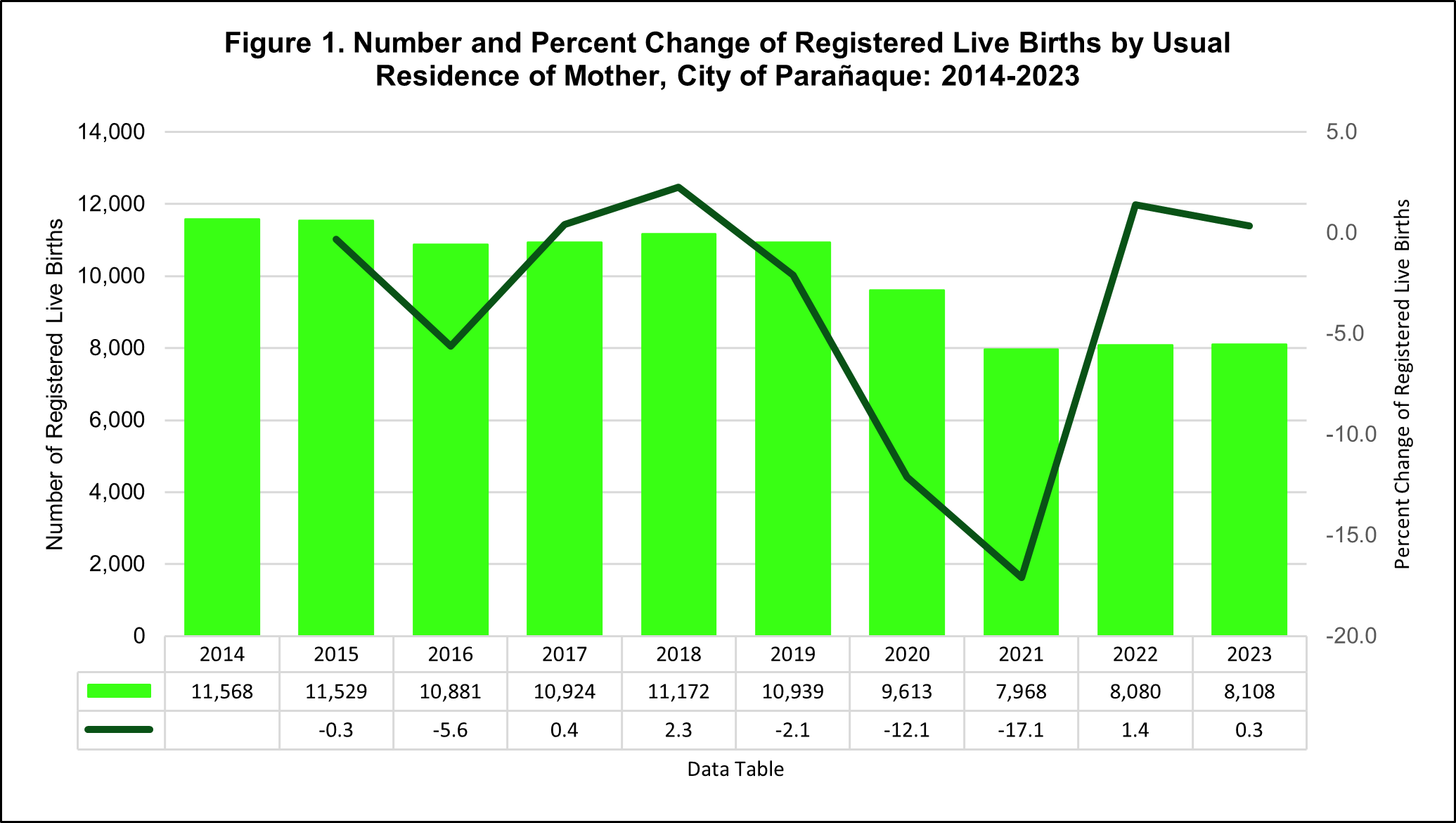
Source: Philippine Statistics Authority, Civil Registration Service, Vital Statistics Division
Male births outnumbered female births in the recorded data.
From January to December 2023, the number of male live births continued to slightly exceed that of females. A total of 4,211 males were recorded, accounting for 51.9 percent of all registered live births, compared to 3,897 females or 48.1 percent. This resulted in a sex ratio of 108 males for every 100 females. A similar trend was noted in 2022, with 4,226 male births or 52.3 percent and 3,854 female births or 47.7 percent, yielding a slightly higher sex ratio of 110 males per 100 females. These figures demonstrate a consistent, though modest, predominance of male live births over the two-year period. The slight increase in the male-to-female ratio, coupled with the overall rise in total births in 2023, indicates a sustained demographic trend favoring male births. (See Figures 2 and 3)
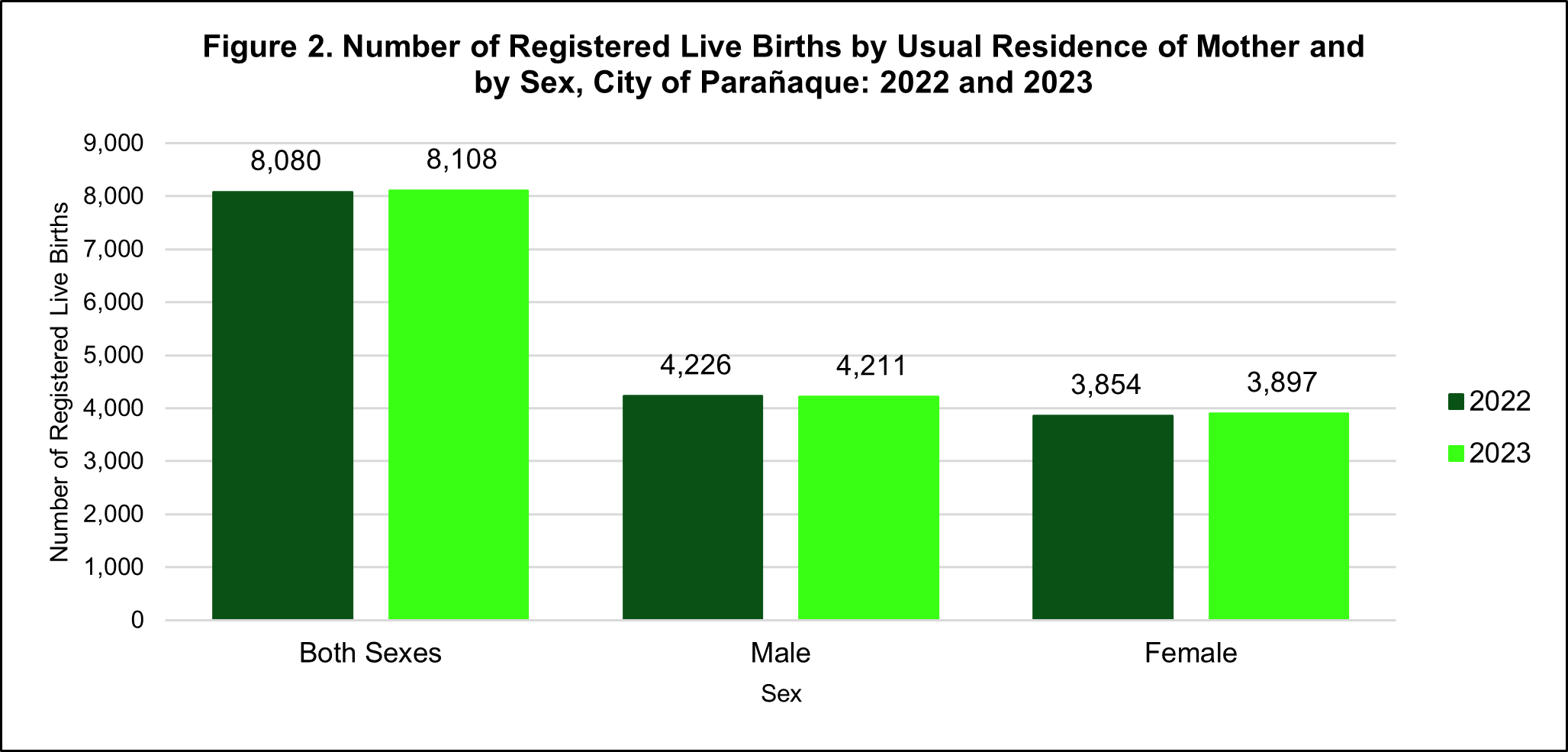
Source: Philippine Statistics Authority, Civil Registration Service, Vital Statistics Division
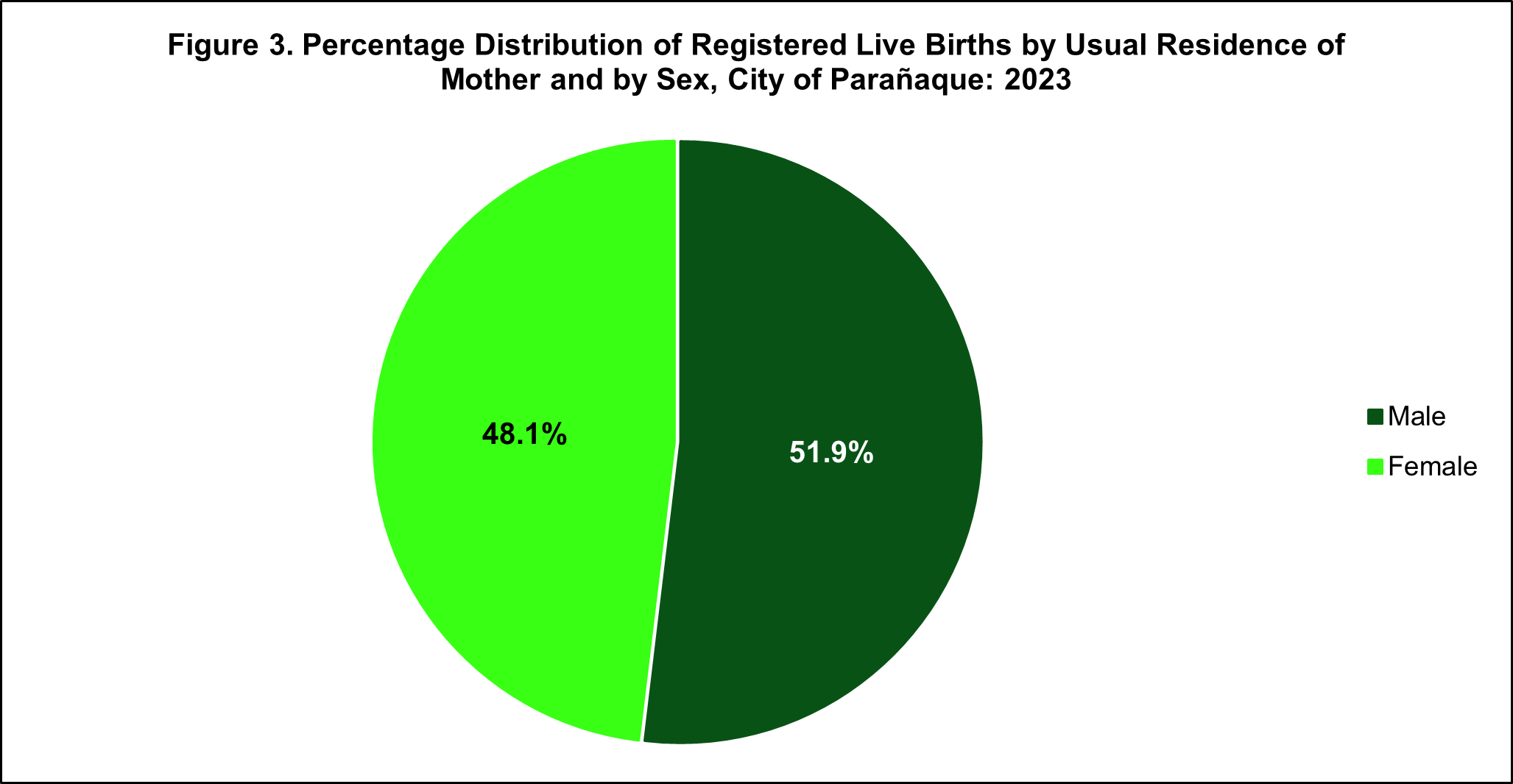
Source: Philippine Statistics Authority, Civil Registration Service, Vital Statistics Division
Most number of births were registered in October.
October recorded the highest number of registered live births in 2023, with a total of 784 births, comprising 9.7 percent of the annual total. This peak was closely followed by September and July, which contributed 9.2 percent and 8.8 percent, respectively. Conversely, April registered the lowest number of live births, accounting for only 7.2 percent of the yearly total. (See Figure 4)
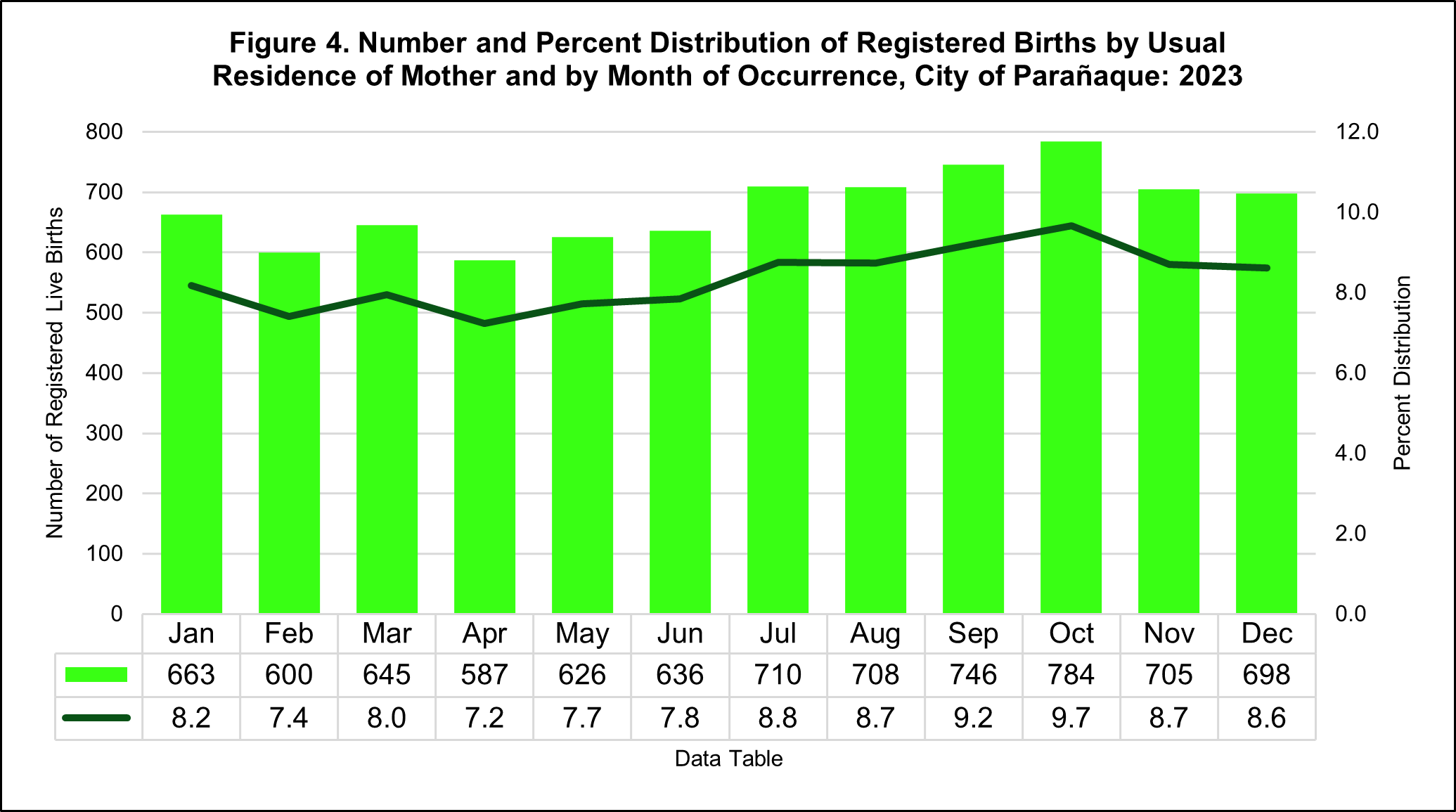
Source: Philippine Statistics Authority, Civil Registration Service, Vital Statistics Division
Proportion of birth deliveries attended by health professionals increased in 2023.
In 2023, 98.0 percent of registered live births in the city were attended by health professionals, an increase of 2.1 percentage points from 95.9 percent in 2022. This rise highlights improved access to and greater confidence in professional childbirth care. In contrast, births assisted by traditional birth attendants, or hilots, declined significantly, dropping from 3.9 percent in 2022 to 1.9 percent in 2023 or a decrease of 2.0 percentage points. Additionally, births categorized as “others” saw a slight decline, slipping from 0.2 percent to 0.1 percent over the same period. (See Figure 5)
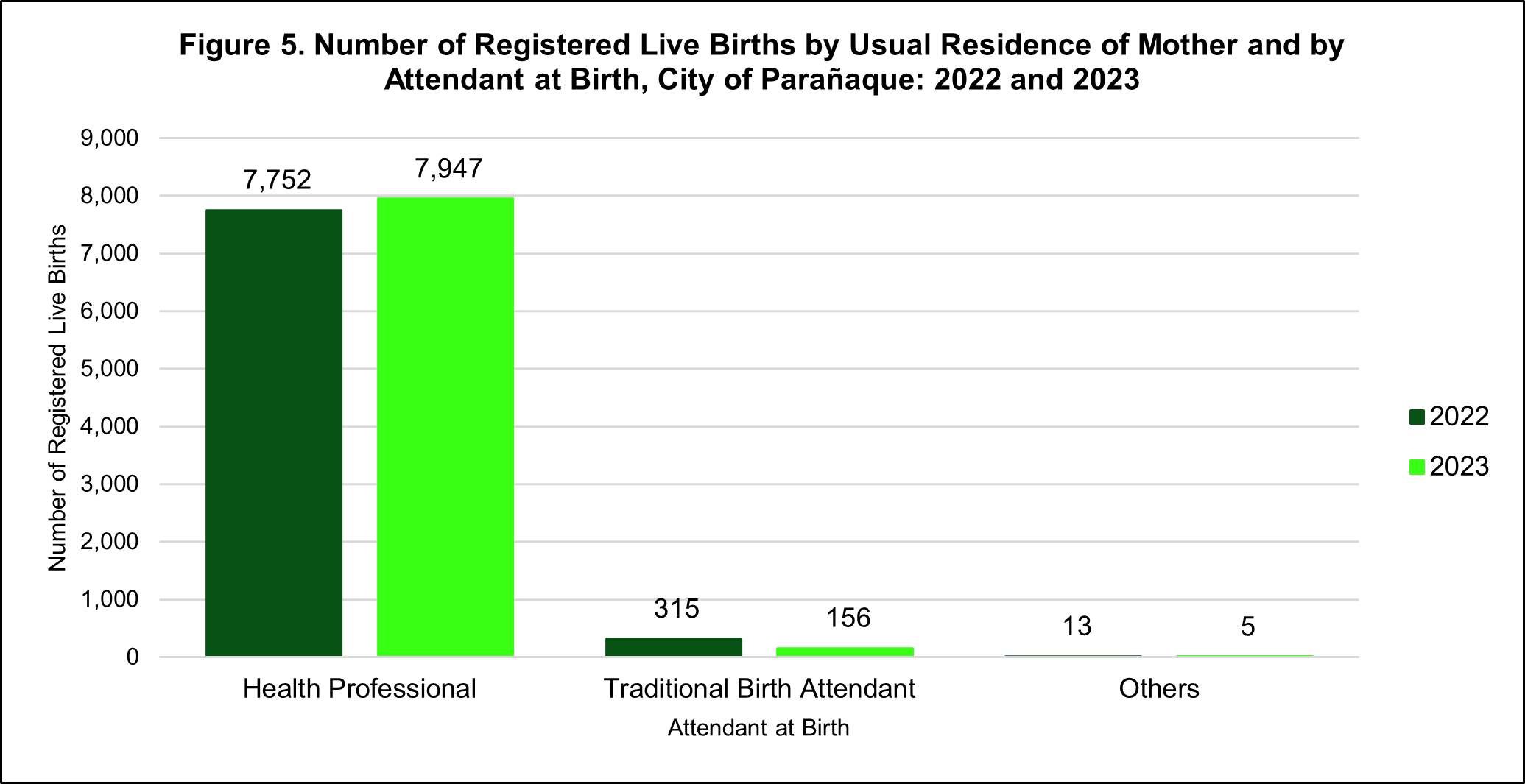
Source: Philippine Statistics Authority, Civil Registration Service, Vital Statistics Division
The majority of registered live births in the City of Parañaque in 2023 were delivered under the supervision of health professionals, which include physicians, midwives, and nurses. Physicians accounted for the highest share, attending to 83.4 percent of total births. This was followed by midwives at 14.4 percent and nurses at 0.1 percent. In contrast, 1.9 percent of births were assisted by traditional birth attendants, while a minimal 0.2 percent were categorized under "others." (See Figure 6)

Source: Philippine Statistics Authority, Civil Registration Service, Vital Statistics Division
Rise in deliveries at health facilities observed in 2023.
In the City of Parañaque, 96.9 percent of total births in 2023 occurred in health facilities, including hospitals, birthing clinics, lying-in clinics, outpatient care centers, and other specialized establishments. This marks a notable increase from the 94.0 percent recorded in 2022, reflecting a sustained shift toward facility-based deliveries. In contrast, only 2.8 percent of births took place at home, while a minimal 0.3 percent were delivered in other locations. (See Figures 7 and 8)
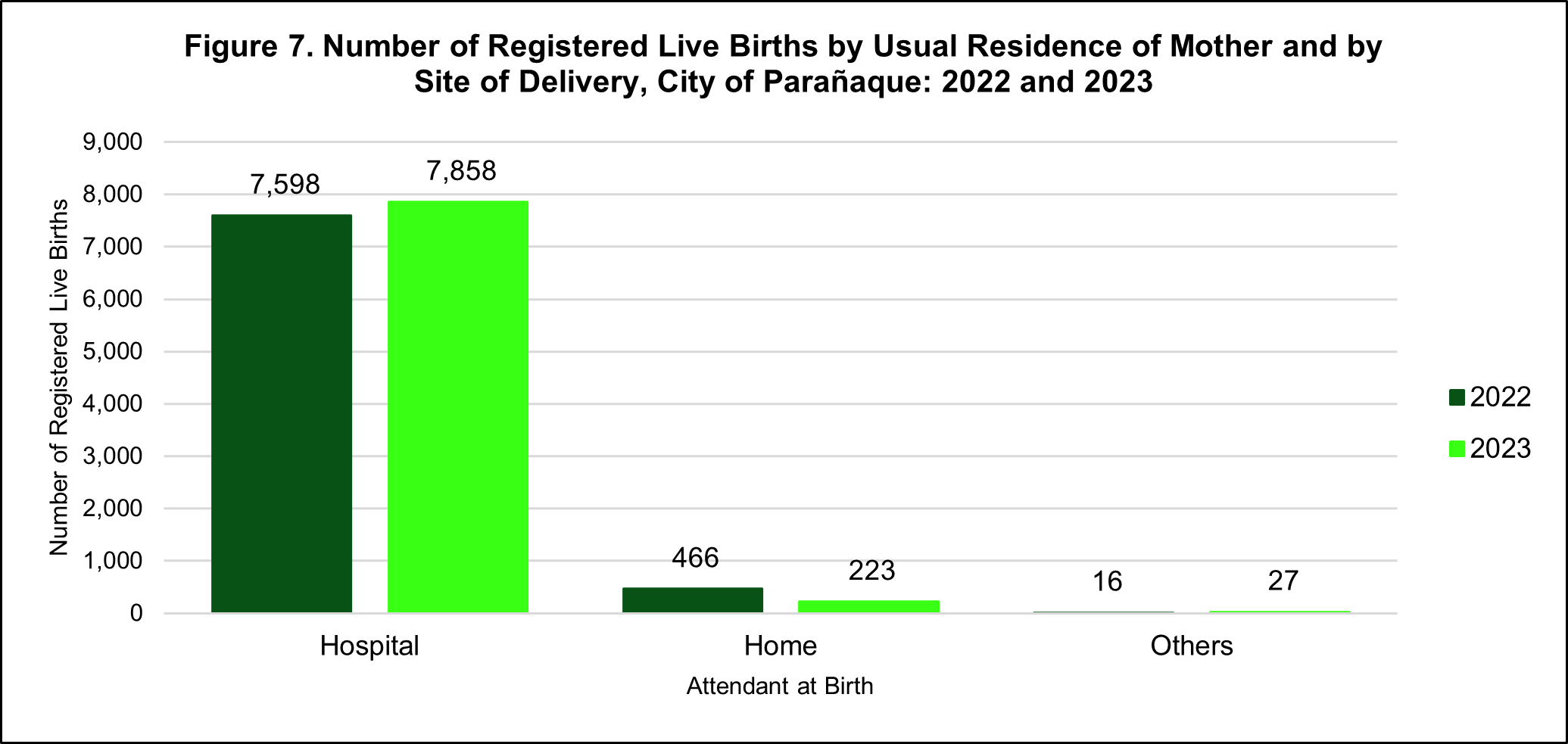
Source: Philippine Statistics Authority, Civil Registration Service, Vital Statistics Division
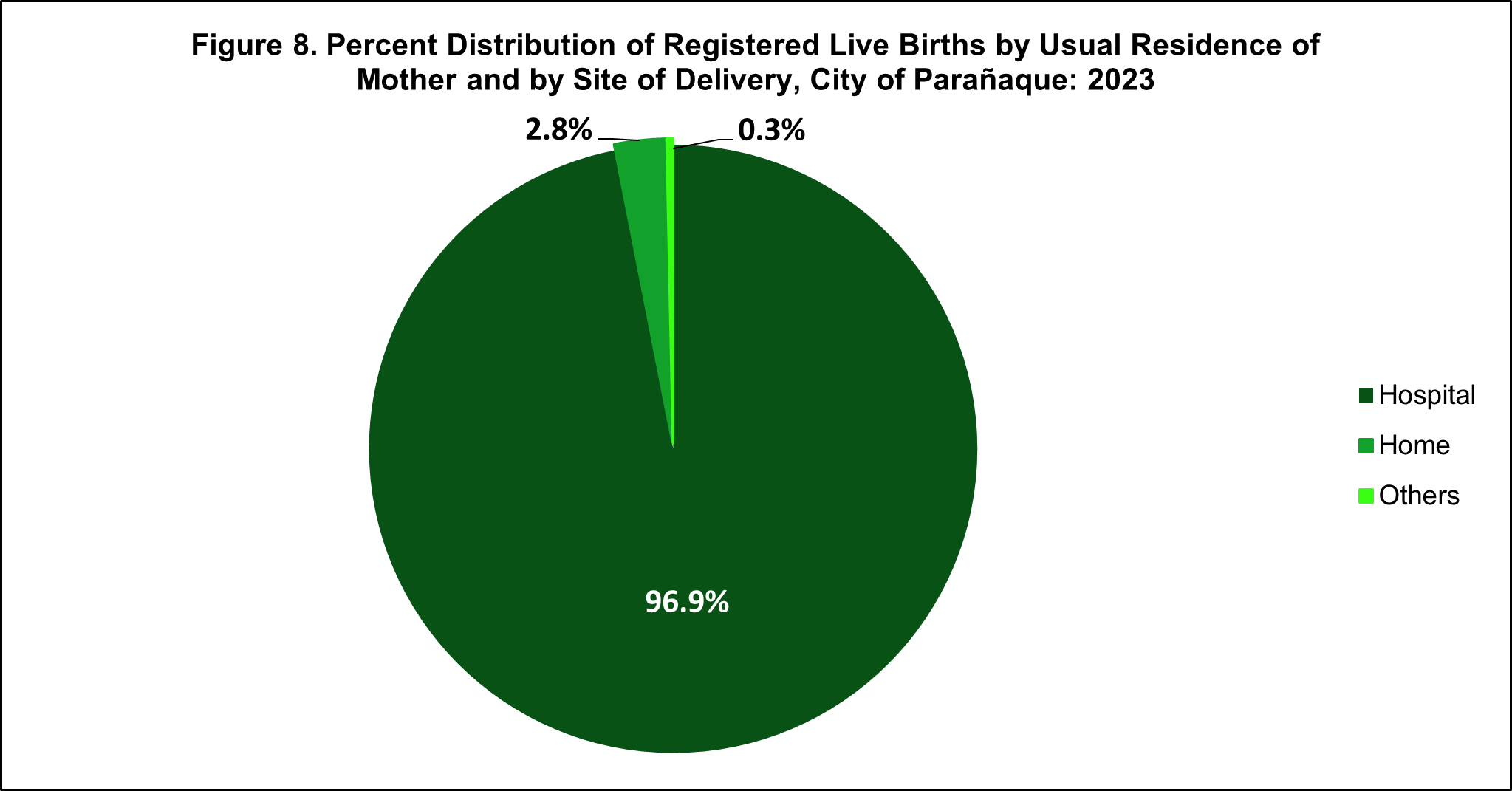
Source: Philippine Statistics Authority, Civil Registration Service, Vital Statistics Division
Most newborn babies weigh more than 2,500 grams.
The nutritional status of newborns is commonly assessed based on their birth weight, with the World Health Organization (WHO) defining low birth weight as less than 2,500 grams (5.5 pounds) at birth.
In 2023, the City of Parañaque reported that the majority of newborns totaling 6,986, or 86.2 percent of registered live births had a birth weight above the low-birth-weight threshold. This figure represents a slight decrease from the 86.9 percent recorded in 2022, while still indicating a generally positive trend in newborn nutritional outcomes. Among these, the largest proportion of newborns, totaling 3,197 or 39.4 percent, weighed between 2,500 and 2,999 grams at birth. (See Figure 9)
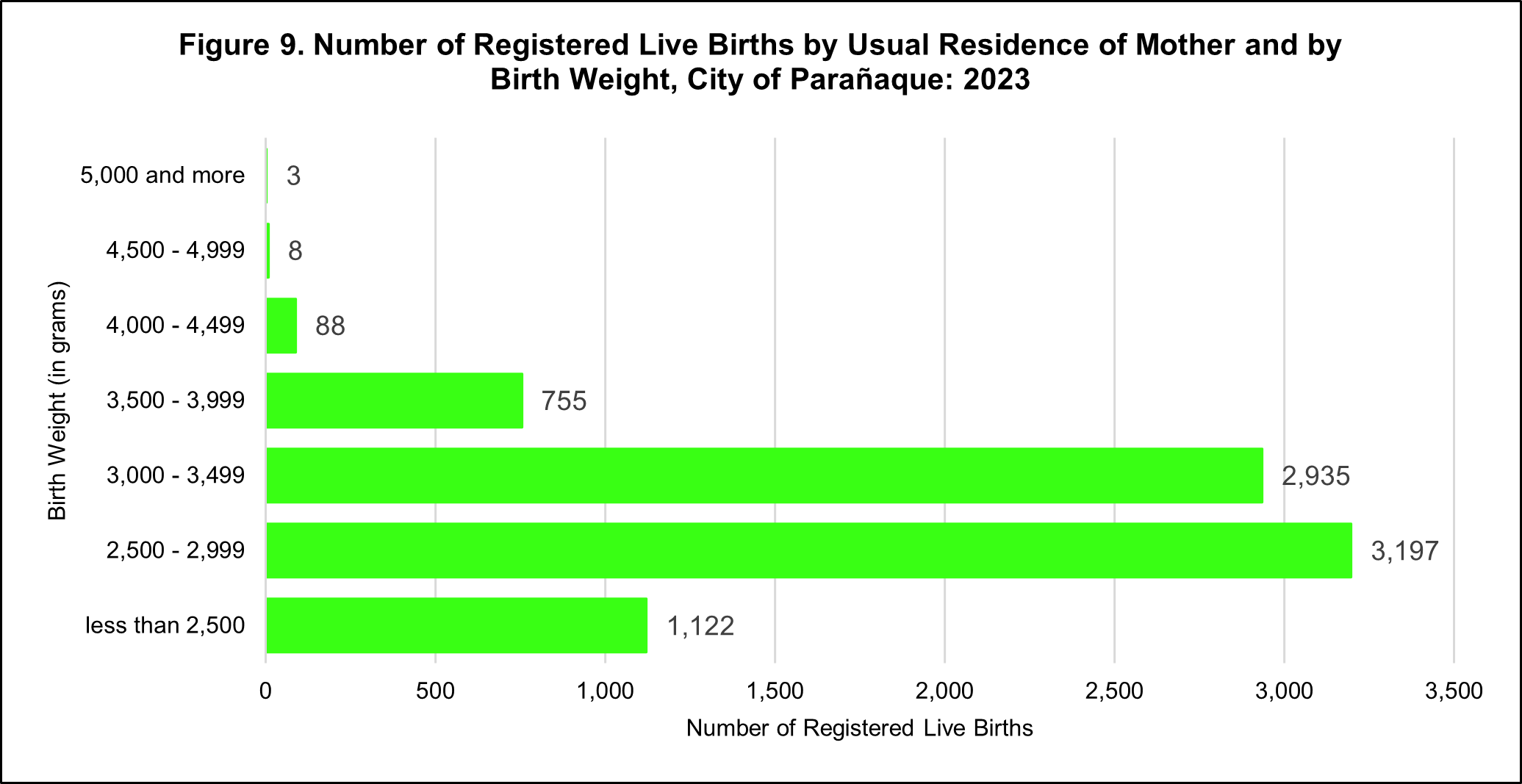
Source: Philippine Statistics Authority, Civil Registration Service, Vital Statistics Division
The majority of babies are born to father and mother aged 25-29 years old.
The City of Parañaque reported a diverse profile of parenthood based on the age distribution of mothers and fathers at the time of registered live births in 2023.
The majority of births were to parents aged 25–29 years, comprising 29.0 percent of mothers and 25.6 percent of fathers. This was closely followed by the 30–34 age group, accounting for 24.9 percent of mothers and 25.1 percent of fathers, highlighting that most childbearing occurs during these prime reproductive years.
Notably, 6.3 percent of total births were to adolescent mothers, or those aged below 20 years, which is significantly higher than the 2.8 percent recorded for adolescent fathers. This disparity underscores that early motherhood remains more prevalent than early fatherhood in the city.
A gradual decline in birth proportions was observed among older age groups. Parents aged 35–39 years still contributed a notable share, with 15.2 percent for mothers and 15.8 percent for fathers. However, births to those aged 40–44 years declined to 4.3 percent among mothers and 7.8 percent among fathers. Live births involving parents aged 45 and above were rare, comprising only 0.2 percent among mothers and 4.0 percent among fathers. Additionally, while the ages of all mothers were reported, 5.5 percent of births involved fathers whose ages were unrecorded. (See Figure 10)
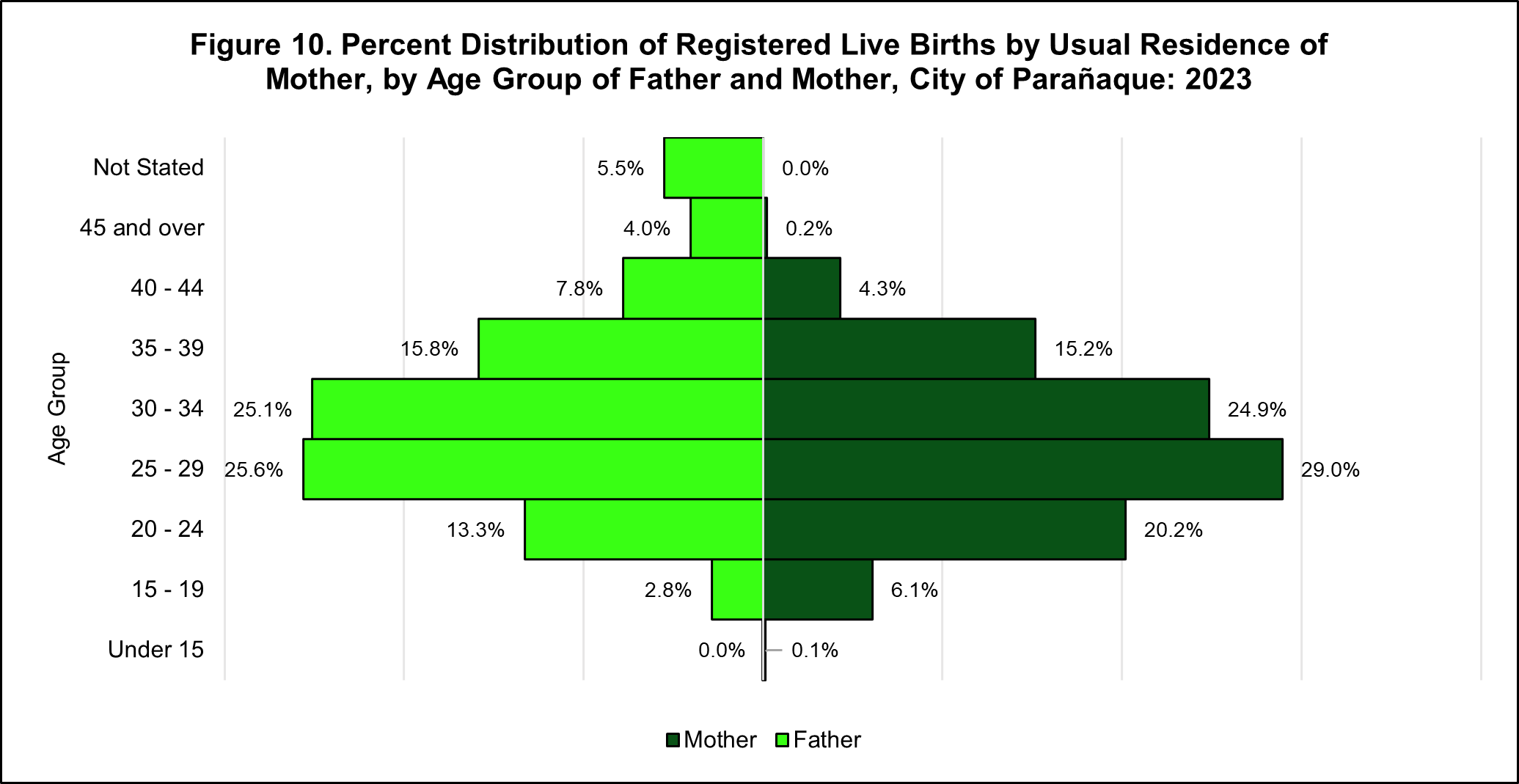
Source: Philippine Statistics Authority, Civil Registration Service, Vital Statistics Division
The median age of mothers at childbirth was 29 years old while for fathers, it was 31 years old. This means that half of the births in 2023 in the City of Parañaque were to mothers and fathers who were at least 29 years old and 31 years old, respectively.
Those between the ages of 17 and younger and 35 years old and over are considered to be at "high risk" of pregnancy. This is because childbearing in these age groups is more likely to have complications during pregnancy and labor that may result in higher morbidity and mortality for both mother and child.
In 2023, approximately 6.3 percent of newborns were born to mothers younger than 20 years old, while around 19.7 percent were born to mothers aged 35 years and older. (See Figure 11)
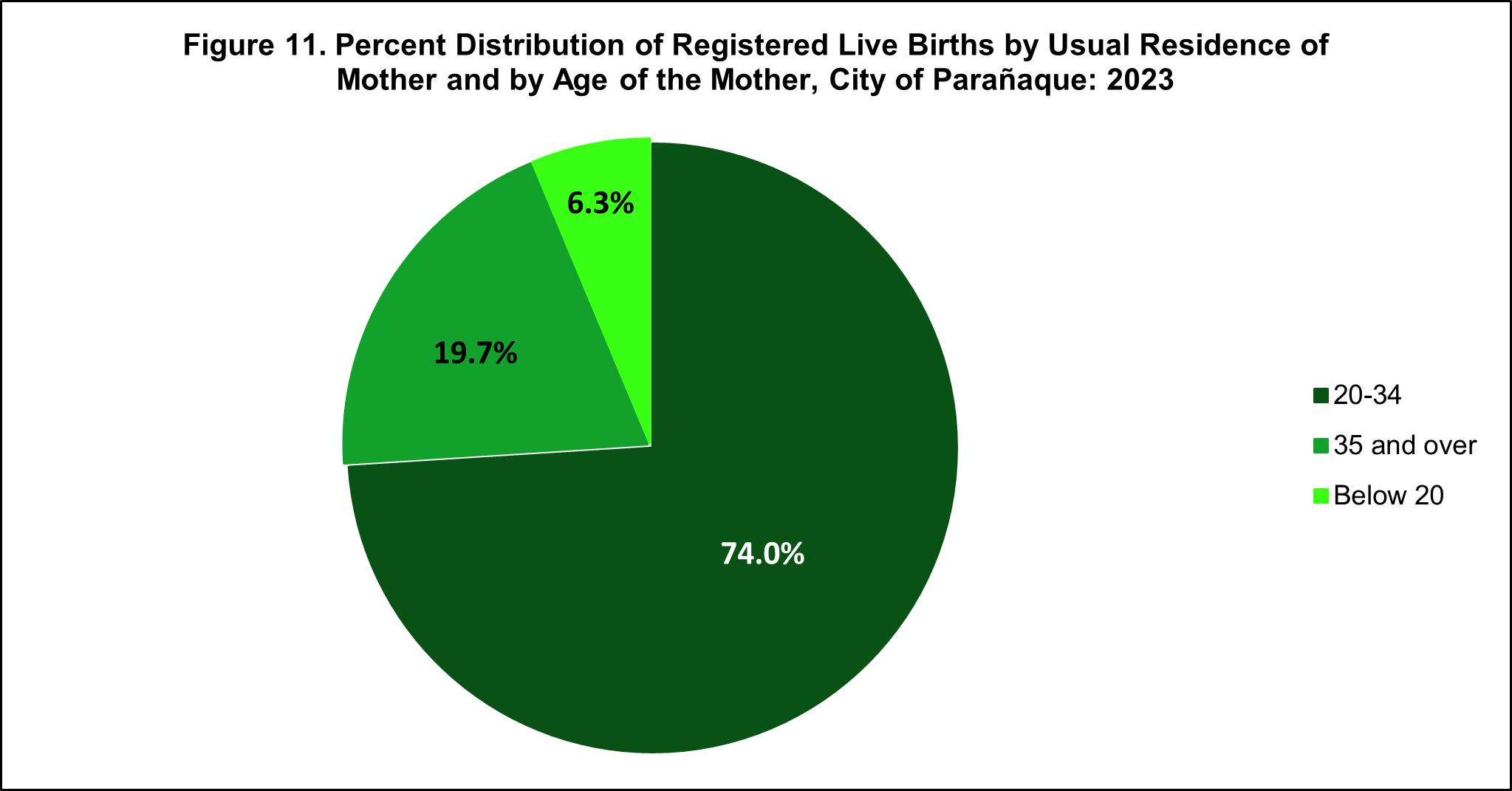
Source: Philippine Statistics Authority, Civil Registration Service, Vital Statistics Division
More than half of newborns were born to unmarried mothers.
The highest incidence of non-marital births in the city in 2023 was recorded among mothers aged 25–29, with 1,709 cases or 31.1 percent of the total. This was followed by mothers aged 20–24, who accounted for 1,483 cases or 27.0 percent, reflecting a notable share among younger women. Meanwhile, 1,060 cases or 19.3 percent were recorded among mothers aged 30–34, indicating a declining trend in this age group’s share compared to those in their twenties. (See Figure 12)
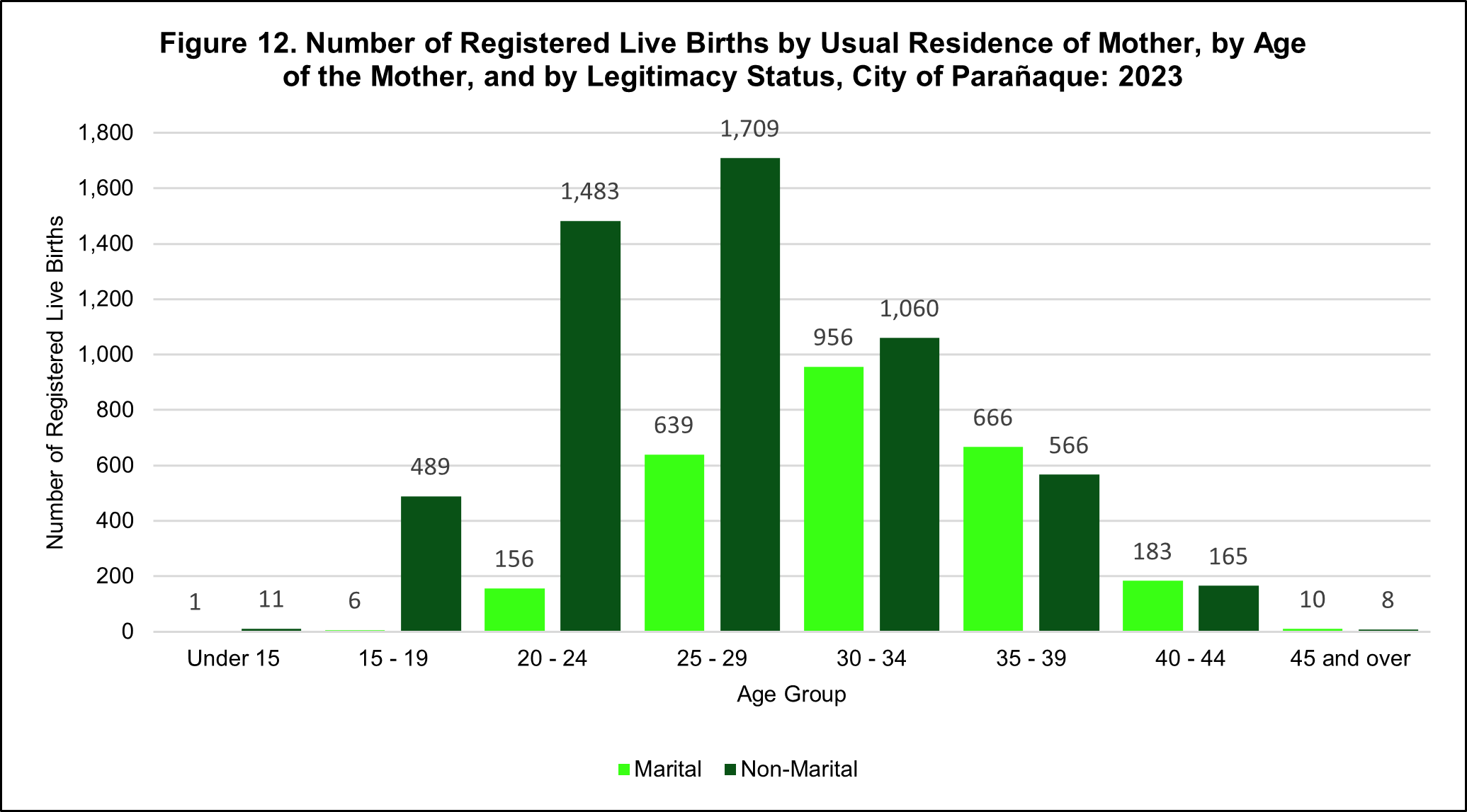
Source: Philippine Statistics Authority, Civil Registration Service, Vital Statistics Division
Moreover, in 2023, a significant majority of live births in the city were classified as non-marital. Out of the total registered births, 5,491 infants or equivalent to 67.7 percent were born out of wedlock, underscoring a prevailing trend of non-marital childbearing. In contrast, only 2,617 births, or 32.3 percent, were to legally married parents, highlighting a substantial disparity between non-marital and marital births during the year. (See Figure 13)
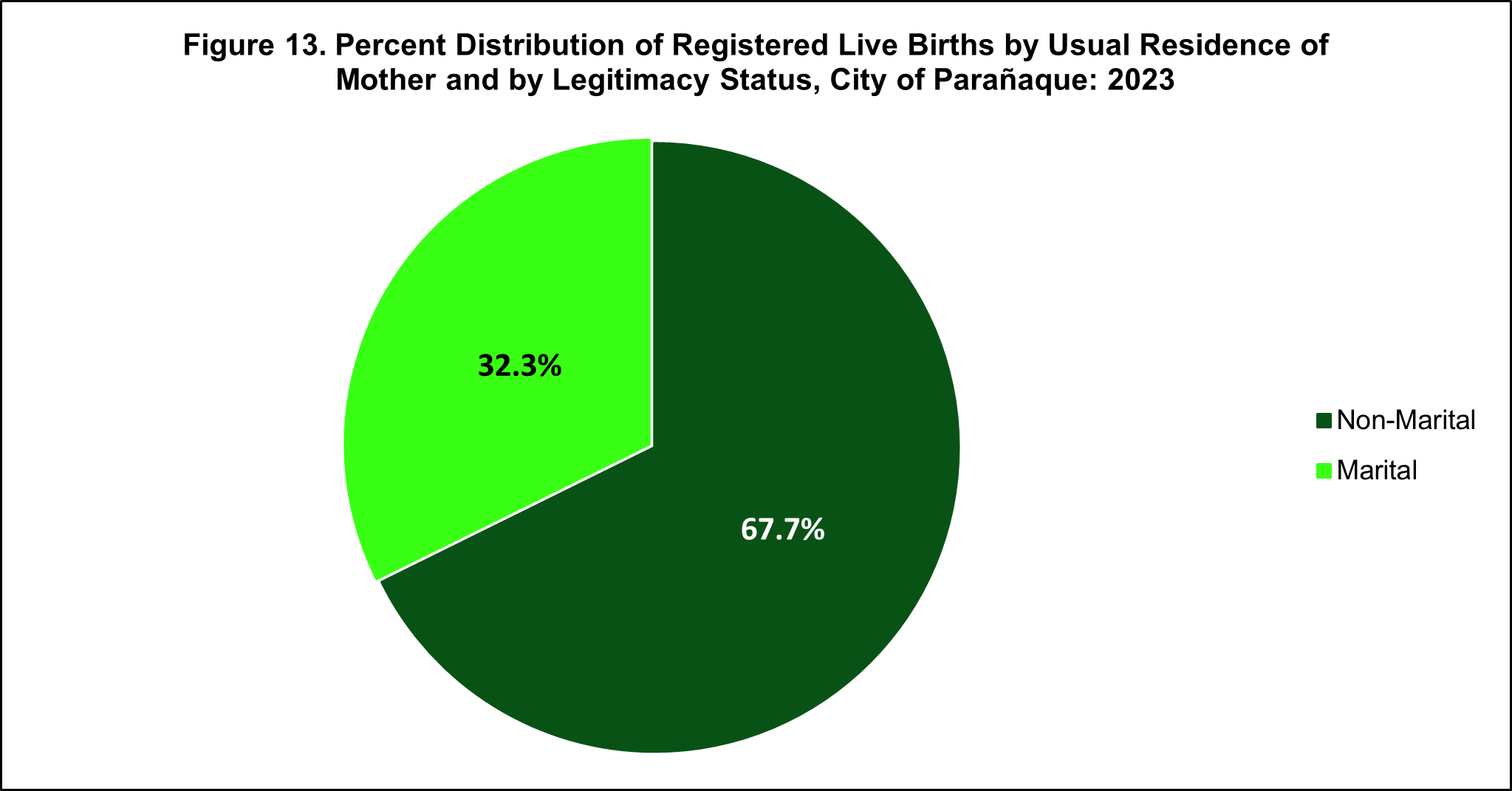
Source: Philippine Statistics Authority, Civil Registration Service, Vital Statistics Division
The city showed distinct patterns in birth legitimacy by mothers’ age. Younger mothers had significantly higher rates of non-marital births, with 91.7 percent among those under 15, 98.8 percent for ages 15–19, and 90.5 percent for ages 20–24. The pattern began to shift among mothers aged 25–29, with 27.2 percent of births being marital. A more balanced distribution appeared at ages 30–34, rising to 47.4 percent, and surpassed 50 percent by ages 35 and over, indicating increasing legitimacy with age. (See Figure 14)
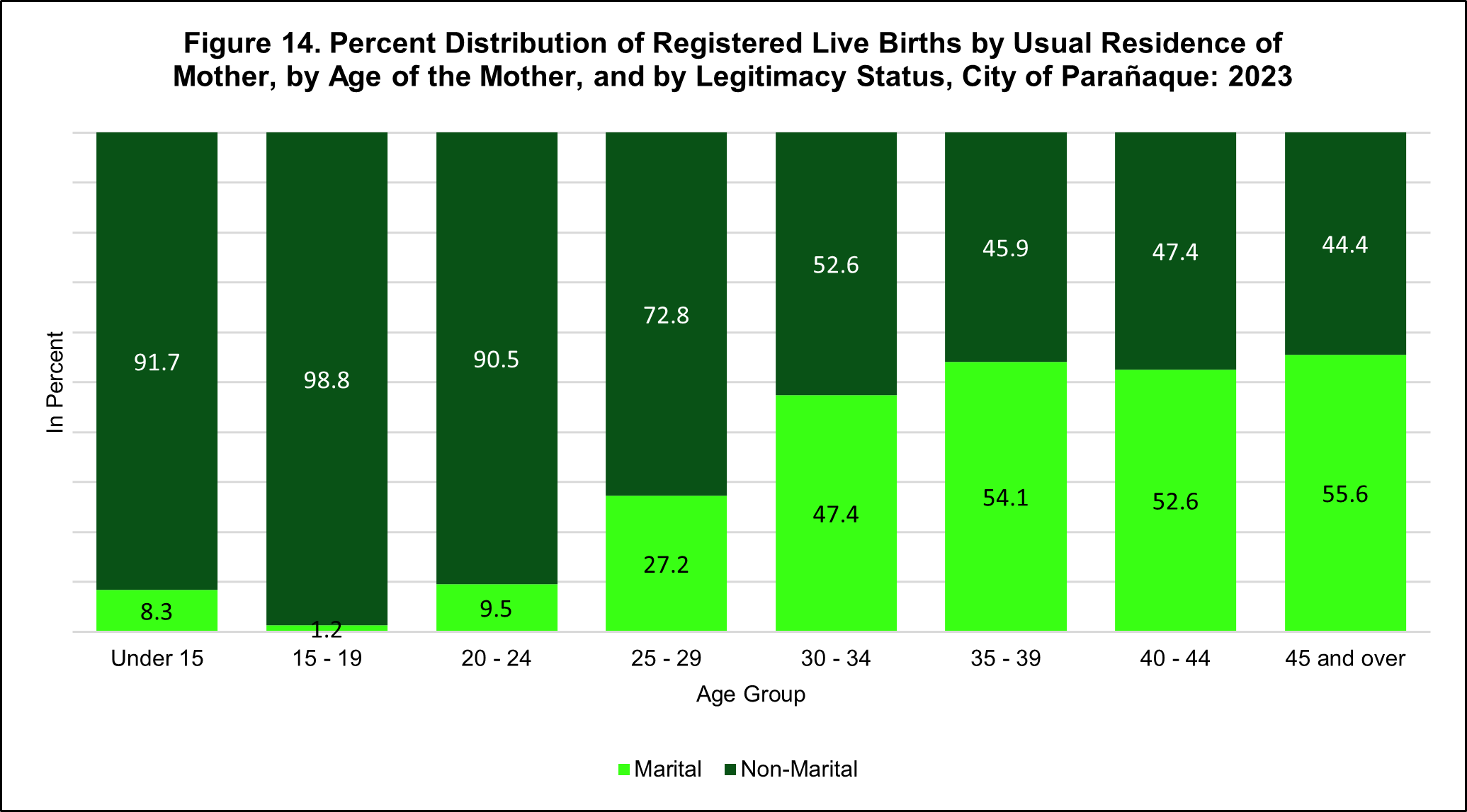
Source: Philippine Statistics Authority, Civil Registration Service, Vital Statistics Division
Almost 90 percent were registered on time.
The birth of a child shall be registered within thirty days from the time of birth to be considered a timely registration. In the City of Parañaque, approximately nine of every ten registered births in 2023 were on time. (See Figure 15)
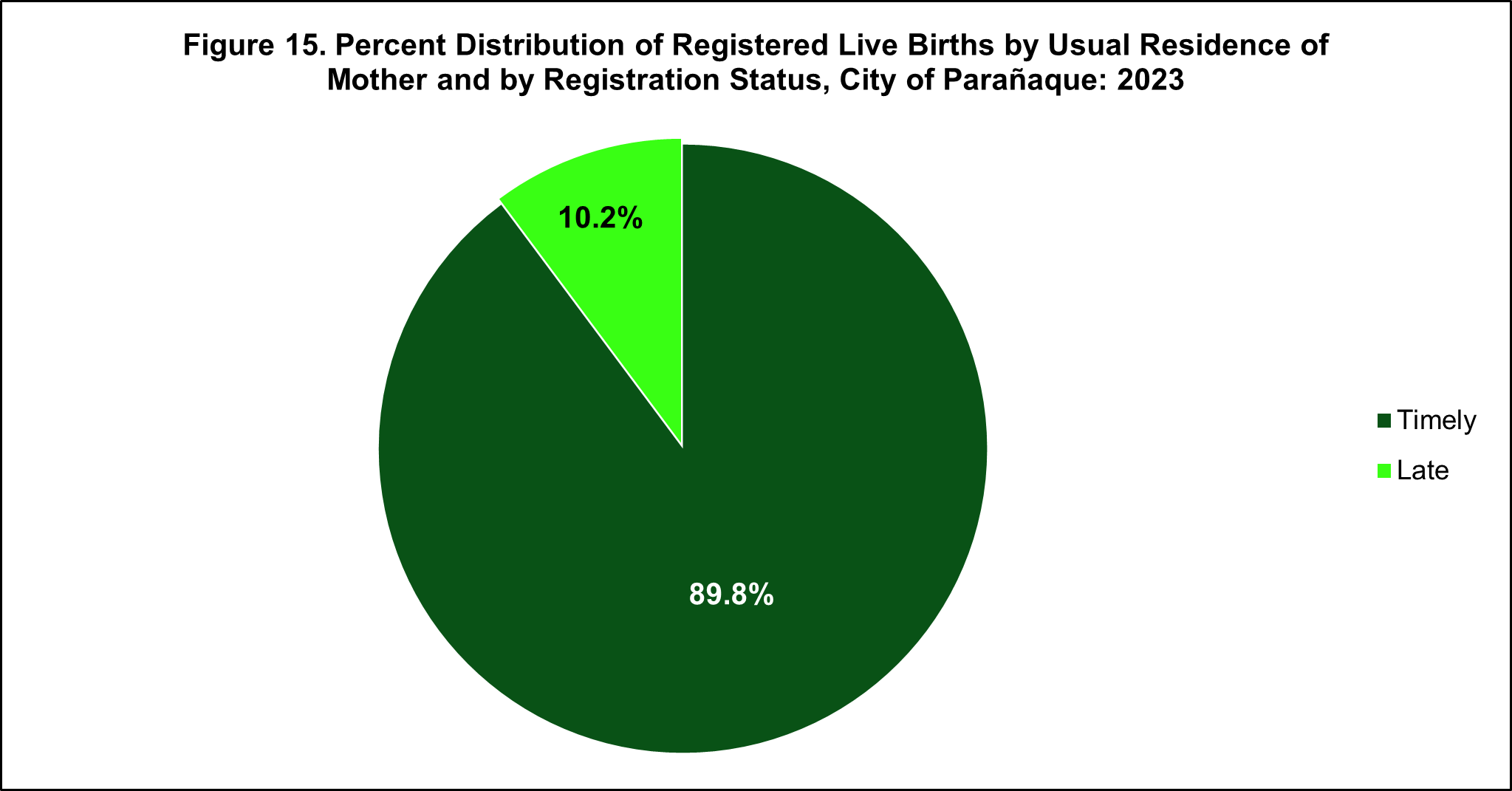
Source: Philippine Statistics Authority, Civil Registration Service, Vital Statistics Division
Technical Notes
Civil Registration is the recording in the appropriate civil registers, vital acts and events that affect the civil status of individuals.
Vital Statistics are derived from information obtained at the time when the occurrences of vital events and their characteristics are inscribed in a civil register.
Vital acts and events are the births, deaths, fetal deaths, marriages, and all such events that have something to do with an individual's entrance and departure from life together with the changes in civil status that may occur to a person during his lifetime. Recording of these events in the civil register is known as vital or civil registration and the resulting documents are called vital records.
• Live Birth - is the complete expulsion or extraction from its mother of a product of conception, irrespective of the duration of pregnancy, which, after such separation, breathes or shows any other evidence of life, such as beating of the heart, pulsation of umbilical cord, or definite movement of the voluntary muscles. Whether or not the umbilical cord has been cut, or the placenta is attached; each product of such a birth is considered live born.
• Sex Ratio - refers to the number of males per one hundred females.
• Usual Residence - refers to the place where the person habitually or permanently resides.
• Crude Birth Rate - The ratio between the number of live births in a population during a given year and the total mid-year population for the same year, usually multiplied by 1,000
For more details, please visit www.psa.gov.ph
ESTRELLA R. VARGAS
Chief Statistical Specialist
Attachments:
1. Table 1. Number and Percent Change of Live Births by Usual Residence of Mother and by Sex, City of Parañaque: 2014-2023
2. Table 2. Number and Percent Distribution of Live Births by Usual Residence of Mother, by Month, and by Sex, City of Parañaque: 2023
3. Table 3. Number and Percent Distribution of Live Births by Usual Residence of Mother and by Attendant at Birth, and by Sex, City of Parañaque: 2023
4. Table 4. Number and Percent Distribution of Live Births by Usual Residence of Mother, by Site of Delivery, and by Sex, City of Parañaque: 2023
5. Table 5. Number and Percent Distribution of Live Births by Usual Residence of Mother, by Birth Weight, and by Sex, City of Parañaque: 2023
6. Table 6. Number and Percent Distribution of Live Births by Usual Residence of Mother, by Age of the Mother, by Sex, and by Legitimacy Status: City of Parañaque: 2023
7. Table 7. Number and Percent Distribution of Live Births by Usual Residence of Mother, by Age of the Father, by Sex, and by Legitimacy Status: City of Parañaque: 2023
8. Table 8. Number of Live Births by Usual Residence of Mother, by Month, and by Registration Status: City of Parañaque: 2023
